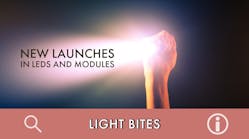Scientist to uncover non-circadian health applications for lighting at Strategies in Light
One of the most exciting opportunities for emerging solid-state lighting (SSL) applications in the upcoming Strategies in Light (SIL) conference program is lighting for health and wellbeing, or human-centric lighting. While we have written and investigated instances of applying light in ways that impact the human circadian rhythm, there are new prospects for potentially treating illnesses or conditions using customized LED-based lighting systems that are developed via various scientific approaches. Neuroscientist Doug Steel is one such individual leading an inquiry into the influence of light on human health conditions outside of those impacted by circadian entrainment. Here Steel offers insights into the difference offered by approaching lighting from a pharmaceutical study vantage point. — CARRIE MEADOWS
As the field of human-centric lighting (HCL) continues to grow, it is apparent that the process of discovering and validating uses of controlled light exposure — and putting them to use in a variety of settings — has been neither straightforward nor driven by consensus. It requires the involvement of many different skillsets including the scientific community, illumination engineers, lighting specifiers and practitioners, and effective communicators who deliver insights and best practices to the user community. These need to connect to product and platform manufacturers and their downstream partners to make the appropriate devices and see that they are used in a proper manner. To those of us involved in the field, it is apparent that this complex network as less of an “ecosystem” and more like a “hairball!”
LEDs Magazine will continue its countdown to Strategies in Light with more industry insights here at ledsmagazine.com. You can find details on the conference program, speakers, exhibitors, and more at strategiesinlight.com.
Related: Strategies in Light keynotes will enlighten the industry on emerging opportunities
To those who are not scientists, it may not be appreciated that there are different kinds of scientists, who contribute to progress in complementary ways. Each brings a different perspective and skillset to the advancement of knowledge and the development of products and processes. Some but not all scientists have expertise in more than one of these areas. It’s useful to understand the perspectives and functions of each type as we approach the study and implementation of human-centric lighting (which we also call lighting for health and wellbeing).
- At the risk of being overly general, basic researchers investigate the structure and function of the nervous system to understand how and where light acts, and study how an organism responds to light. Such studies are conducted under rigidly controlled laboratory conditions.
- Applied scientists work in environments that more closely resemble the natural world, where there are many more uncontrolled variables that result in data that is often less precise.
- Clinical scientists study the same phenomena in patient care settings, and look at health outcomes that lead to new healthcare procedures.
- Translational scientists consider the results from these other forms of investigation and figure out how to structure them in the form of a business, matching technology to uses, markets, revenue models, and other elements that constitute a company.
Related: Strategies in Light tracks send strong signals about lighting prospects
As a translational scientist, I draw from my years spent doing neuroscience R&D in the pharmaceutical industry developing new drugs to treat nervous system illnesses. The pharma industry uses a somewhat different version of the scientific process to develop a drug, which I apply to the uses of light exposure. Under this approach, commercial development occurs through asking and answering the following questions:
- Is there a mechanism underlying a drug effect, or is it a non-specific result? (Every developed drug must function via a known or theorized mechanism.)
- Is there a druggable target? (Can you point to a specific location or pathway in the brain at which a drug acts?)
- What biological changes can be measured as proof that a drug or treatment is working?
- Is there a sizable market for the drug? (An inside joke is that drug companies prefer chronic conditions over cures because patients will continue to need to take a drug for a long time.)
- Is it novel, and can it successfully make it through FDA approval?
So this brings us back to the state of science and translation in the field of human-centric lighting. By far the dominant area of application of light exposure is circadian rhythm management. There are numerous outstanding researchers and practitioners working in this area, and it is these uses that are most often heard of inside the lighting community. I do not consider myself a member of this group, but I will be sharing my Strategies in Light session with Dr. Martin Moore-Ede, who is well-known in this field and participated in the inaugural Lighting for Health and Wellbeing Conference last summer in Newport Beach, CA.
Related: 10 Things to Love about Strategies in Light 2018
By applying the playbook of the pharma industry, I have identified a number of current and future areas for commercial development of human-centric lighting and light exposure therapy, which should open the doors to new health uses of lighting, and provide confidence to the lighting industry that this will be a significant growth area in the coming decade. In my session at SIL, I will be discussing some of these health applications, and provide the scientific rationale for their use. Applications to be addressed include:
- Depression
- Chronic headache
- Sensory gating and modulation
- Emotional status
- Pain perception
- Immune system function
I hope that you are able to join us for an interesting discussion on the potential of LED-based lighting in health and wellbeing applications.
DOUGLAS STEEL, PhD, is a translational scientist with NeuroSense, a medical technology consultancy developing phototherapies for treating a number of nervous system conditions including PTSD, sensory processing disorders, migraine headache, depression, and emotional and stress-related conditions. Steel received his PhD in biomedical sciences from Columbia University P&S.






